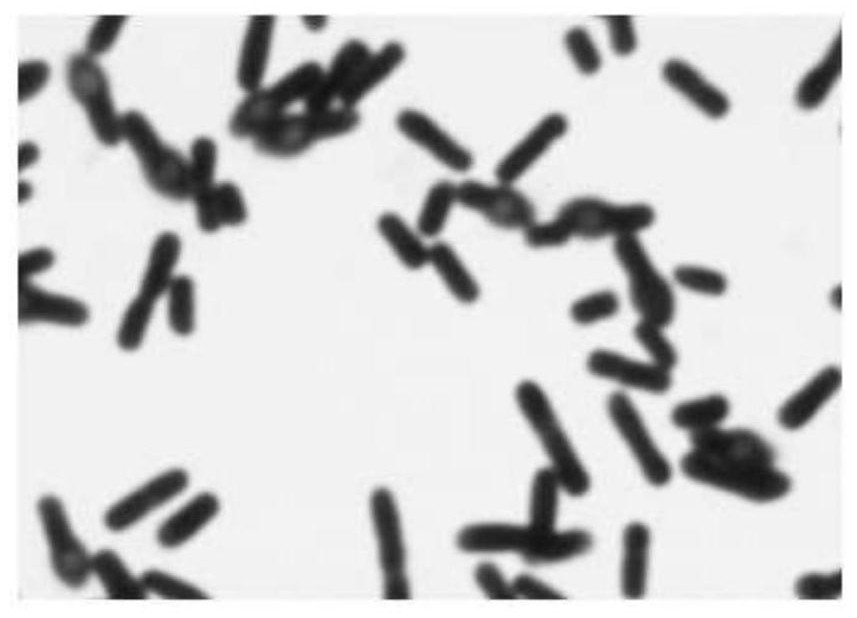Boron-resistant lysinibacillus sp. with bacteriostatic ability and application of boron-resistant lysinibacillus sp.
A technology of Bacillus lysine and ability, applied in the field of microorganisms, can solve the problems of poor clinical use effect, undeveloped and used, etc., and achieve the effects of low production cost, high safety and good application prospects.
- Summary
- Abstract
- Description
- Claims
- Application Information
AI Technical Summary
Problems solved by technology
Method used
Image
Examples
Embodiment 1
[0031] The isolation of embodiment 1 boron-resistant lysine bacillus LBS-2018
[0032] Green onions selected from the forage breeding experiment field of Jiangsu Academy of Agricultural Sciences were used as screening samples, and Escherichia coli ATCC25922 and clinically isolated multidrug-resistant Escherichia coli 3001 were used as indicator bacteria to carry out the test.
[0033] Take 1-2g green onion sample, grind and pulverize, add 1mL sterile PBS, treat in water bath at 80°C for 20min, inoculate LB medium at 2% ratio, and incubate at 37°C, 200r / min for 12h. For gradient dilution, draw 100 μL of the suspension for each gradient and evenly spread it on a sterile solid LB plate, and culture overnight (generally more than 12 hours) in a 37°C incubator. After colonies grow out, bacteria are randomly selected for purification.
[0034] Using double-layer agar point inoculation method, the concentration of indicator bacteria was adjusted to 1×10 6 CFU / mL, pipette and add 10...
Embodiment 2
[0035] The identification of embodiment 2 boron-resistant lysine bacillus LBS-2018
[0036] 1. Observation of strain morphology Inoculate LBS-2018 three-section line on LB plate, culture at 37°C, and observe the colony morphology the next day, as shown in figure 1 ; Use an inoculation loop to pick an appropriate amount of bacterial lawn, spread it on a clean glass slide with a drop of distilled water, air-dry and fix it, then use crystal violet mixed solution, iodine solution, 95% ethanol and safranin solution to stain in turn, wash and air-dry, and mirror check, such as figure 2 .
[0037] 2. 16S rDNA sequence analysis Kit was used to extract the DNA of LBS-2018, using primers 27F: 5′-AGAGTTTGATCCTGGCTCAG-3′ (SEQ ID NO.2), 1492R: 5′-TACGGTACCTTGTTACGACTT-3′ (SEQ ID NO.3) Carry out PCR amplification, and the composition of the PCR reaction system: 12.5 μL of 2×Taq PCR Master Mix, 1 μL of primers 27F and 1492R, 1 μL of template DNA, and finally make up to 25 μL with steriliz...
Embodiment 3
[0049] Example 3 Preparation of LBS-2018 bacterial agent
[0050] Take LBS-2018 out of the low-temperature storage refrigerator, scrape an appropriate amount of culture from the inoculation loop, inoculate the LB agar plate in three sections, and culture it upside down in a 37°C constant temperature incubator for 12h-20h. Take it out the next day, pick up a single colony and transfer it to LB culture medium, culture it at 37°C for 12-20 hours, and use it as the activated LBS-2018 strain. The activated strains were inoculated into new LB culture medium at a ratio of 1-2%, and cultured at the optimal culture temperature of 32°C and 200rpm for 20-24h with shaking for subsequent experiments.
PUM
 Login to View More
Login to View More Abstract
Description
Claims
Application Information
 Login to View More
Login to View More - Generate Ideas
- Intellectual Property
- Life Sciences
- Materials
- Tech Scout
- Unparalleled Data Quality
- Higher Quality Content
- 60% Fewer Hallucinations
Browse by: Latest US Patents, China's latest patents, Technical Efficacy Thesaurus, Application Domain, Technology Topic, Popular Technical Reports.
© 2025 PatSnap. All rights reserved.Legal|Privacy policy|Modern Slavery Act Transparency Statement|Sitemap|About US| Contact US: help@patsnap.com



